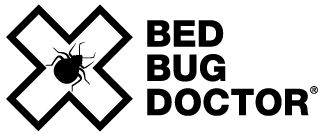|
 |
 |
| |
Bed bugs
-
Quick
fact
sheet:
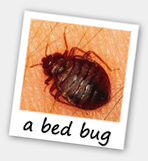 Bedbugs
are very flat, which
allows them to hide in
tiny crevices. A crack
wide enough to fit the
edge of a credit card
can harbour bedbugs (even
cracks in the ceiling!).
In the daytime, they
tend to stay out of the
light, preferring to
remain hidden in such
places as mattress
seams, mattress
interiors, bed frames,
nearby furniture,
carpeting, skirting
boards, inner walls,
tiny wood holes, or in
the general bedroom
clutter. Bedbugs can be
found on their own, but
more often than not, due
to circumstances, are
found congregated in
groups. They are not
social insects, and do
not build or live in
nests. These groups of
bedbugs are most often
found in beds, usually
either in the seams of a
mattress, or within the
structure of the bed
frame itself. But they
can also be found in a
wide variety of
locations in a home,
such as behind skirting
boards, behind a picture
frame, within books, in
telephones, or bedside
radios, and within the
folds of curtains.
Bedbugs are capable of
travelling as far as 100
feet to feed, but
usually remain close to
the host in bedrooms or
on sofas where people
may sleep. They feed
every five to 10 days
and the manner in which
infestations spread room
to room throughout a
home will usually differ
from case to case. It is
important to inspect all
adjacent rooms for
infestation, as bedbugs
travel easily and
quickly along pipes and
boards. In treatment, it
is important to consider
the insides of walls as
potential places for
bedbug infestation. The
actual size of a bedbug
infestation is variable
and hugely dependent on
the time elapsed since
the initial infestation.
All infestations start
small and grow
exponentially from this
point. Even a single
female bedbug brought
into a home can result
in a huge population
expansion once offspring
start breeding with
offspring. It needs to
be noted that the
visible bedbug
infestation does not
necessarily represent
the infestation as a
whole, as there may be
infestations elsewhere
in a home, however, the
insects do have a
tendency to stay close
to their hosts (hence
the name "bed" bugs), so
this can be quickly
assessed to understand
the full scale of the
infestation. Bedbugs
are very flat, which
allows them to hide in
tiny crevices. A crack
wide enough to fit the
edge of a credit card
can harbour bedbugs (even
cracks in the ceiling!).
In the daytime, they
tend to stay out of the
light, preferring to
remain hidden in such
places as mattress
seams, mattress
interiors, bed frames,
nearby furniture,
carpeting, skirting
boards, inner walls,
tiny wood holes, or in
the general bedroom
clutter. Bedbugs can be
found on their own, but
more often than not, due
to circumstances, are
found congregated in
groups. They are not
social insects, and do
not build or live in
nests. These groups of
bedbugs are most often
found in beds, usually
either in the seams of a
mattress, or within the
structure of the bed
frame itself. But they
can also be found in a
wide variety of
locations in a home,
such as behind skirting
boards, behind a picture
frame, within books, in
telephones, or bedside
radios, and within the
folds of curtains.
Bedbugs are capable of
travelling as far as 100
feet to feed, but
usually remain close to
the host in bedrooms or
on sofas where people
may sleep. They feed
every five to 10 days
and the manner in which
infestations spread room
to room throughout a
home will usually differ
from case to case. It is
important to inspect all
adjacent rooms for
infestation, as bedbugs
travel easily and
quickly along pipes and
boards. In treatment, it
is important to consider
the insides of walls as
potential places for
bedbug infestation. The
actual size of a bedbug
infestation is variable
and hugely dependent on
the time elapsed since
the initial infestation.
All infestations start
small and grow
exponentially from this
point. Even a single
female bedbug brought
into a home can result
in a huge population
expansion once offspring
start breeding with
offspring. It needs to
be noted that the
visible bedbug
infestation does not
necessarily represent
the infestation as a
whole, as there may be
infestations elsewhere
in a home, however, the
insects do have a
tendency to stay close
to their hosts (hence
the name "bed" bugs), so
this can be quickly
assessed to understand
the full scale of the
infestation.
For
more in depth info,
please visit our
bedbug symptoms &
identification page.
|
|
 |
|
|
 |
|
|
How
to spot the signs
- Quick fact sheet:
Spotting the signs of an
infestation is one of the
most important weapon
against the spread of bed
bugs. As with most problems
of this nature, the earlier
you detect the problem, the
quicker, cheaper and easier
it is to eradicate them, and
most importantly with the
least chance of spreading
them to friends and family.
For most people who have
little knowledge of bed
bugs, the first signs they
will spot are small
clustered bites, normally
located on the limbs and
neck/head areas:

It is
very important that these
bites are diagnosed
correctly and above you can
see a picture of what to
look out for. You will
notice that the bed bug
bites are clustered in
groups of roughly 3 and do
not have a dark "blood red"
centre to them (unless you
have been vigorously
scratching them!). The tiny
bumps you can see are formed
where the bed bug has
pierced the skin for feeding
and injected a tiny bit of
saliva that contains 2
active ingredients required
for feeding. The first is an
anticoagulant that stops the
blood from clotting (to
allow a free flow of blood
for feeding), and the second
is an
anaesthetic to numb the
area (to enable undetected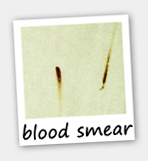 feeding). Depending upon
your reaction to each of
these active ingredients,
you will get a raised bump
where the bed bug has been
feeding. Reactions range
from absolutely no sign at
all, to a swelling the size
of an egg, but the bites
shown above are what 90% of
people will experience
(for more details on
symptoms and treatment of
bedbug bites, please visit
our
bedbug bites page).
Next
you might find a few brown
coloured "blood smears" on
the bed sheets, these are
very small and unless you
are specifically looking for
them they are easy to miss.
The cause of these marks are
due to the bed bugs feeding
on blood and as they walk
away, some will seep out
creating a streaking pattern
(just like the “blood smear”
image shown here). Once
aware of the problem,
further investigation will
reveal 3 more key signs, the
first will be little black
stains on the bed frame,
mattress, surrounding
furniture, floor boards or
skirting boards. These black
marks are caused by the
waste faecal matter produced
by bed bugs after feeding
and are mostly located
around where the bed bugs
have been living.
Unfortunately this is a sign
of the advanced stages of an
infestation, and ideally the
infestation should have been
eradicated before these
signs become visible to an
untrained person.
feeding). Depending upon
your reaction to each of
these active ingredients,
you will get a raised bump
where the bed bug has been
feeding. Reactions range
from absolutely no sign at
all, to a swelling the size
of an egg, but the bites
shown above are what 90% of
people will experience
(for more details on
symptoms and treatment of
bedbug bites, please visit
our
bedbug bites page).
Next
you might find a few brown
coloured "blood smears" on
the bed sheets, these are
very small and unless you
are specifically looking for
them they are easy to miss.
The cause of these marks are
due to the bed bugs feeding
on blood and as they walk
away, some will seep out
creating a streaking pattern
(just like the “blood smear”
image shown here). Once
aware of the problem,
further investigation will
reveal 3 more key signs, the
first will be little black
stains on the bed frame,
mattress, surrounding
furniture, floor boards or
skirting boards. These black
marks are caused by the
waste faecal matter produced
by bed bugs after feeding
and are mostly located
around where the bed bugs
have been living.
Unfortunately this is a sign
of the advanced stages of an
infestation, and ideally the
infestation should have been
eradicated before these
signs become visible to an
untrained person.
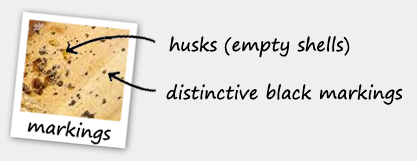
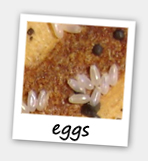 Next,
where the bedbugs have been
nesting you may find what
look like empty bed bug
shells, these are called
husks and are created
through the moulting process
whereby the bedbug will shed
it's skin periodically as it
grows from a nymph to the
full adult male stage. It is
only at this stage that bed
bugs can breed, so the
discovery of these husks is
bad news with regards to
controlling the population.
At this stage, every day
counts, and unfortunately
these husks are a sign of an
advanced infestation, so
care should be taken to not
disturb or spread the
infestation. The next key
sign will be actual bed bug
eggs. These are smaller than
a grain of rice (as shown in
the photograph) and again,
unfortunately this is a sign
of an advanced infestation.
The eggs have a sticky
coating which enables them
to bond with any surface and
are usually laid out of
sight so they can remain
safely hidden until hatched. Next,
where the bedbugs have been
nesting you may find what
look like empty bed bug
shells, these are called
husks and are created
through the moulting process
whereby the bedbug will shed
it's skin periodically as it
grows from a nymph to the
full adult male stage. It is
only at this stage that bed
bugs can breed, so the
discovery of these husks is
bad news with regards to
controlling the population.
At this stage, every day
counts, and unfortunately
these husks are a sign of an
advanced infestation, so
care should be taken to not
disturb or spread the
infestation. The next key
sign will be actual bed bug
eggs. These are smaller than
a grain of rice (as shown in
the photograph) and again,
unfortunately this is a sign
of an advanced infestation.
The eggs have a sticky
coating which enables them
to bond with any surface and
are usually laid out of
sight so they can remain
safely hidden until hatched.
For more in depth info,
please visit our
bedbug symptoms &
identification page. |
|
 |
|
|
|
|
|
|
|
 |
|
|
Booking your
appointment:
 Eradicate
your bed bug problem
today by using one of
our fully trained and
experienced bed bug
technicians. Simply call
us now and speak to a
member of our bookings
team on our 24 hour
booking line:
0207 112 8366
or just send us an
email at
bookings@bedbugdoctor.co.uk.
All our technicians have
unmarked vans and
unbranded uniforms so
you can be assured of a
very discreet service. Eradicate
your bed bug problem
today by using one of
our fully trained and
experienced bed bug
technicians. Simply call
us now and speak to a
member of our bookings
team on our 24 hour
booking line:
0207 112 8366
or just send us an
email at
bookings@bedbugdoctor.co.uk.
All our technicians have
unmarked vans and
unbranded uniforms so
you can be assured of a
very discreet service.
For more in depth info,
please visit our
bedbug treatment &
extermination page.
|
|
|
|
|
|
|
|
|
|
|
|
|
|
|
|
|
|
|
|
|
|
|
|
 |
|
|
|
 |
|
|
Areas covered:
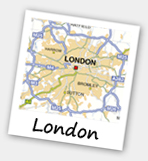 As
speed is of the essence
when dealing with bed
bugs, we aim to start
your treatment as soon
as possible (depending
upon existing bookings).
We have teams of
professionals ready to
deploy within the London
and M25 area, all fully
trained and experienced. As
speed is of the essence
when dealing with bed
bugs, we aim to start
your treatment as soon
as possible (depending
upon existing bookings).
We have teams of
professionals ready to
deploy within the London
and M25 area, all fully
trained and experienced.
|
|
|
|
|
|
|
|
|
|
|
|
|
|
|
|
|
|
|
|
|
|
|
|
 |
|
|
|
 |
|
|
Corporate rates:
 Bed
Bug Doctor Ltd specialise in the extermination,
detection and preventative treatment of bed bugs for
hotels, youth hostels, shops and care homes. To get
a quote and arrange an on-site visit, please contact
us on
0207 112 8366
or just send us an email
at
bookings@bedbugdoctor.co.uk Bed
Bug Doctor Ltd specialise in the extermination,
detection and preventative treatment of bed bugs for
hotels, youth hostels, shops and care homes. To get
a quote and arrange an on-site visit, please contact
us on
0207 112 8366
or just send us an email
at
bookings@bedbugdoctor.co.uk
**
Landlords and letting agents get special pricing
too, get in touch and find out what we can do for
you today. |
|
|
|
|
|
|
|
|
|
|
|
|
|
|
|
|
|
|
|
|
|
|
|
 |
| |
|
 |
|
|
Contact details:
Bed Bug Doctor Ltd.
180-186 Kings Cross Rd,
London,
England,
WC1X 9DE.
0207 112 8366
info@bedbugdoctor.co.uk
Company No: 07639483 |
|
|
|
|
|
|
|
|
|
|
|
|
|
|
|
|
|
|
|
|
|
|
 |
| |
|
 |
|
|
Bed Bug news:
|
|
|
 |
|
|
|
© Bed Bug Doctor Ltd
London 2014 |
|
